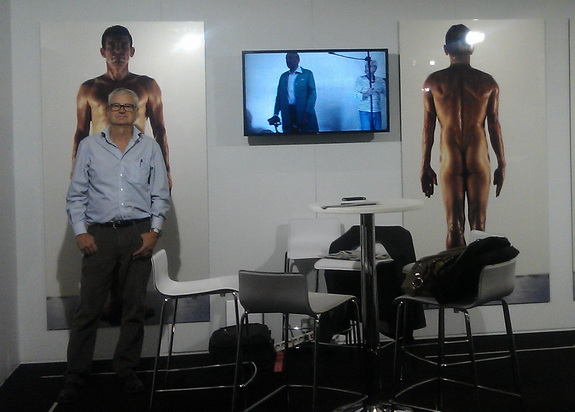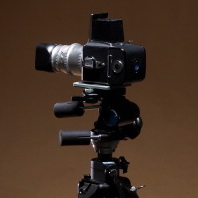In a world in which retro-look smartphone photos can be created in an instant, it’s nice to see that experimentation is continuing at the large-format, traditional end of the photography spectrum.
At the Photokina 2012 exhibition in Cologne, Germany, photographic artist Heino Heimann showed some of the 50 x 80 inch direct-exposure color prints he created using ILFOCHROME media and the room-sized Chrome Camera he built at Ilford’s headquarters in Marly, Switzerland.
Because of the print size and quality of the materials used, each one-of-a-kind print replicates the optical powers of the human eye in terms of image sharpness and resolution. And because each print is totally unique and can’t be replicated, photographs created with the camera may have greater value in the eyes of certain buyers.
Ilford is making the Chrome Camera available to artists and photography students who want to experiment with this one-of-a-kind device and Ilfochrome, the world’s only direct-positive color media for darkroom photo printing.
The Chrome Camera measures 6 meters long, 2.5 meters high, and 2.5 meters wide (about 20 x 8 x 8 feet) and features a lens Heimann found in Italy.
Ilfochrome uses a dye destruction positive-to-positive process to create images. The material features 13 layers containing azo dyes, gelatin, and silver halide grain coated on a dimensionally stable polyester base. Tests conducted by Wilhelm Imaging Research have indicated that the Ilfochrome resists fading under display conditions longer than any other known photographic color material. Ilfochrome prints also display excellent image clarity and color purity.
How the Process Works
Here is how Heimann explained the process he used to create the prints shown at Photokina:
“First I position the subject. Then I position the lights. Sometimes I take a test shot with a digital camera first. If I do this, I have to use a grey filter to reduce the light by 3 stops. Ilfochrome has an ISO/ASA of 6, whereas normal camera sensitivity is 100 ISO/ASA.
If I’m working with a model, the model looks at the light and I hold an LED sensor close tothe eyes. I then go inside the camera and look at the wall where the image is projected and where the Ilfochrome paper will hang. I move the wall to focus the image. When it’s focused I close the camera.
I put the basket head on the lens. This acts as a shutter/lens hood so that inside the camera is dark. I then put the paper in place on the wall inside the camera.
I go outside of the camera and stand in front of it. I check that the model is in exactly thecorrect position using the LED sensor. This is necessary in order for the image to be perfectly sharp. After I remove the LED sensor, I open the shutter, release the flash, and close the shutter. I go inside the camera and roll the paper up, putting it inside a giant tube. I walk over to the department of Ilford Ilfochrome expert Mr. Jean-Noel Gex. We develop the paper in the darkroom for 18 minutes. Then the image is ready.”
Because the process of creating the image is so unique, the large-format print looks different from those created from enlarged digital files output on large-format inkjet printers.
“With other methods of photography, you would take the picture and then store it on a negative or on a data stick or other software. Then you would print it out. At each of these steps along the way, small changes are made to the images,” explains Heimann. “With direct exposure onto Ilfochrome, you freeze a moment in time in a precise way. With other photography methods you always get a copy, but with direct exposure you capture the moment.”
Each print is totally unique, because the subject inevitably shifts or changes during a shoot.
“Sometimes I make a series of images, such as flower shots,” Heimann says. “But after an hour, the flowers will change and wilt. Changes also happen when I’m taking multiple shots with the same model.”
Artists Are Invited to Experiment
The Chrome-Camera can be rented by international photo artists who want to explore the creative potential of the camera and make their own prints on Ilfochrome. College and university groups from Switzerland and beyond are also invited to visit the Ilford site to experiment with the Chrome-Camera and learn about the direct exposure process.
Before arranging a visit to the studio, Heimann said he would first help you determine whether or not your concept would be feasible with the camera. He will also help with preparation, technique, lighting and equipment.
Heimann is particularly interested in helping students learn about the process because he wants to encourage them to “Move away from shooting pictures and start making pictures.”
He believes the Chrome-Camera can help photography students better understand traditional photography: “It’s a totally manual process, which is very rare these days. As with slow cooking, with slow photography you have to take it step by step, be patient and you have to do everything for yourself. This is totally the opposite of the popular approach we see today with photographers encouraged to push the button and let technology do the rest. I say be the button!”
“Ilford has been enabling photographers to achieve their artistic vision for over 130 years,” says Lars Sommerhäuser, Chief Operating Officer at ILFORD. “Our Ilfochrome media is a truly unique product and we anticipate the creation of some eye-opening work when it is used to develop images from the Chrome-Camera.”
About Heino Heimann
Heimann has worked as a freelance studio photographer in Germany, France, and the U.S. for a number of brands including Kodak and Minolta. His previous experience in medium and large format photography includes the Big Players billboard project with Foto Museum Frankfurt.
LINKS
Contact Heino Heimann about Visiting the Chrome-Camera at Ilford in Marly, Switzerland



